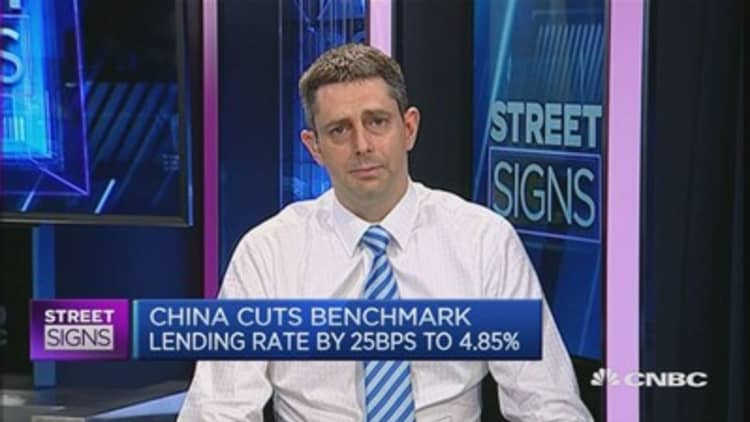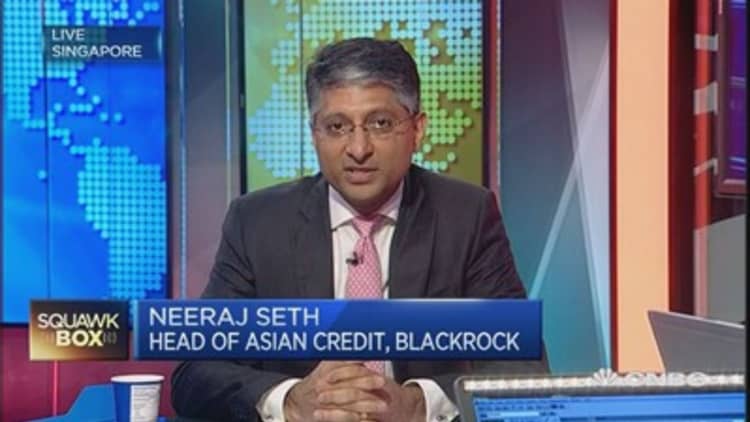
Equities in China finished in bear-market territory on Monday, even as the country's central bank rolled out a bigger-than-expected easing package over the weekend aimed at stabilizing the market.
The benchmark opened up almost 1 percent briefly before slipping deeper into negative territory over the course of the day, losing as much as 7.5 percent to hit an intra-day low of 3,875.04. The Shanghai bourse eventually clawed back some lost ground to end down 3.3 percent at a more than two-month low.
Since June 12, the benchmark index has fallen 21.5 percent from a high of 5166.35, breaching the 20 percent threshold that defines a bear market. Analysts attribute the dramatic plunge to a raft of initial public offerings (IPOs) that locked up an estimated 6.7 trillion ($1.1 trillion) worth of funds, as well as regulatory efforts to rein in excessive levels of leverage.
This sharp correction, accompanied by bouts of extreme volatility, is in stark contrast to the blistering run-up that saw the Shanghai Composite soaring more than 150 percent over the past 12 months.
Analysts read the People's Bank of China's (PBOC) surprise policy easing as a move to stabilize the stock market. The PBOC on Saturday cut the benchmark one-year lending and deposit rates by 25 basis points to 4.85 percent and 2.0 percent respectively. It also reduced the RRR by 50 basis points at for select lenders serving rural areas and small to medium-sized enterprises.
China last cut both interest rates and the RRR at the same time in December 2008, at the peak of the Global Financial Crisis.
Read MoreWill the 'Zhou put' stave off a crash?
According to J.P Morgan, the three major stock indexes in China — the Shanghai Composite, the smaller Shenzhen Composite and the start-up ChiNext board — haven fallen 19, 20 and 25 percent respectively over the past two weeks. Without a policy response from the central bank, the stock market could have "evolved into a disorderly correction process."
"The economy hasn't deteriorated much since they last cut rates [so] it must be the markets but a quarter percent off funding costs isn't going to change the world when you are getting margin calls in a stock limit down," Richard Jerram, chief economist at the Bank of Singapore, told CNBC's "Street Signs Asia" on Monday.

But Monday's tumble indicates that the central bank may need to do more to soothe market jitters.
"We think the latest policy easing has demonstrated a very strong official intention to generate a 'soft-landing' in the equity market. In that regard, should the sell-off continue at the current pace, further market support measures could be announced in the coming days," wrote Aidan Yao, senior emerging market economist at AXA Investment Managers, in a note.
For Macquarie's Erwin Sanft, the Chinese authorities could look to bringing down the seven-day reverse-repo rate as its next step to give a sustained lift to China's main stock market.
"Clearly, the PBOC will be very worried with what they see today.. and they are likely to look at what other things can be done. The 7-day repo rate inched back up to 3 percent today so injection of money into the inter-bank market to bring that down to 2 percent or lower could be a good next step as the unwinding of margin financing accelerates," Erwin Sanft, Macquarie's head of China strategy, told CNBC on Wednesday.
Elsewhere in China, the Shenzhen Composite slumped 6.05 percent to a seven-month low on Monday, while the blue-chip CSI 300 index closed down 3.3 percent to its lowest level since April 17. The ChiNext board took the worst hit, down 7.35 percent and ending the day at a near two-month trough.

